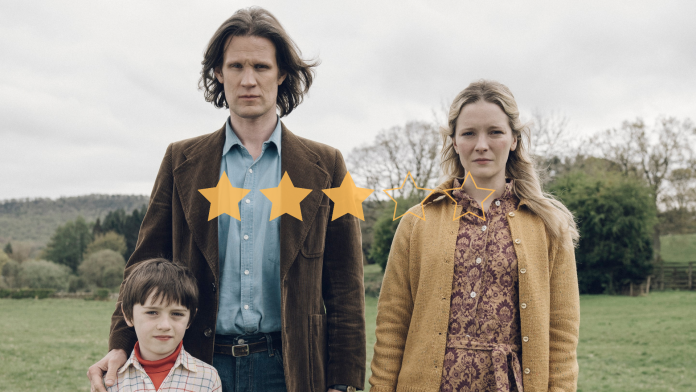Like farmland frozen over, this film is cold and lacking in vitality. Starve Acre builds a dense atmosphere of dread from its ‘70s rural Yorkshire setting, panoramas of the Moors and an unnerving score by Matthew Herbert making for a technically achieved piece. Yet references to Pagan rituals, Anglo-Saxon treasures and other folky whisperings designed to creep out audiences feel half-baked rather than sincerely spooky.
★★★☆☆
Juliette (Morfydd Clark) and her husband Richard (Matt Smith), a lecturer in medieval history, have moved to Richard’s old family farmhouse isolated on the Yorkshire Moors. Whilst trying their best to bring up their troubled son Owen (Arthur Shaw), tragedy strikes. As Juliette grapples with her trauma, Richard sinks into his work by trying to unearth the rumoured roots of an ancient tree which once stood on their land. In doing so, Pagan powers are released from the soil and a mysterious spirit called Dandelion Jack begins to infiltrate the couple’s lives.
This film follows in the tradition of atmospheric horror films which have shot to popularity in recent years. Films like Midsommar (2019) and The Lighthouse (2019), from A24 darlings Ari Aster and Robert Eggers, prioritise atmosphere and aesthetics over all else—arguably to their detriment. While not making such bold aesthetic choices, Starve Acre is a similarly stunningly shot film. Cinematographer Adam Scarth relishes in filming the barren slants of the Yorkshire Moors. There are many shots of the couple’s grey farmhouse in the distance, suffocated by the purple and pine earth around it. Like Emily Brontë’s Wuthering Heights, the Moors in this film are rich in mystery and dread, a natural source of creeps which Starve Acre utilises well.
While the unpredictable score also does some atmospheric heavy lifting, the plot is too straightforward to match the tone. Without spoiling anything, it isn’t hard to guess what disaster occurs early on in the film. The aftermath is also familiar, recounting the stages of grief but with a Wickerman-esque flavour. A subplot involving a reanimated deceased hare is done with excellent practical effects, but the metaphor might as well be written in subtitles on screen.
There are some interesting ideas here, but they are spread too thin. Richard’s generational trauma is consigned to a scrapbook of creepypasta photos, while the spirit Dandelion Jack is frustratingly ambiguous. At one point he seems to give Juliette telekinetic powers, a development which is never expanded upon. These folk horror touchstones are enjoyable and, again, technically well achieved. The roots of the ancient tree are a particularly sinister prop, appearing like writhing grey tentacles of a beheaded eldritch horror. But none of these individually enjoyable folk horror strands are ever tied into a knot, instead remaining limp and loose.
The Verdict
Fans of folk horror and Wicca will get a kick out of Starve Acre thanks to the Pagan references. There is nothing offensive about the film and it definitely deserves a watch; but perhaps this is the problem. The Wickerman (1973) and The Blair Witch Project (1999), titans of folk horror, are still seared into viewer’s minds today, their controversy still sustaining. Coming out of Starve Acre, a brilliant title that oozes with phonetic menace, and feeling slight indifference is a sign that it has missed the mark set by its folk horror forefathers. Like the Yorkshire Moors, this film is beautiful and sparse, yet decidedly less awe-inspiring.
Words by Barney Nuttall
Starve Acre is in UK cinemas from 6th September.
Support the Indiependent
We’re trying to raise £200 a month to help cover our operational costs. This includes our ‘Writer of the Month’ awards, where we recognise the amazing work produced by our contributor team. If you’ve enjoyed reading our site, we’d really appreciate it if you could donate to The Indiependent. Whether you can give £1 or £10, you’d be making a huge difference to our small team.
